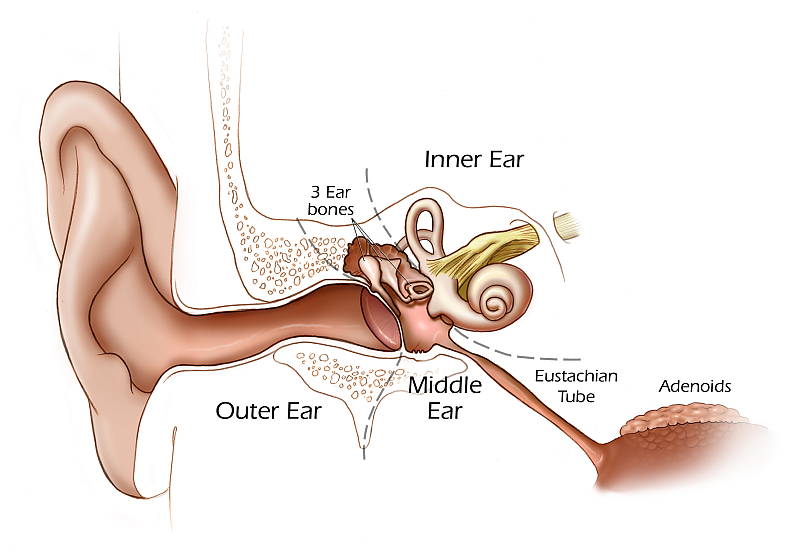Perforated Ear Drum
The eardrum, otherwise known as the tympanic membrane, separates the ear canal from the middle ear. A perforated eardrum occurs when the eardrum ruptures, leaving an opening between the middle and outer ear. This can be problematic.
Causes
A ruptured eardrum commonly results from injury or trauma, or following a chronic infection. Very loud and sudden noises (i.e., explosion or gunshot) can cause the eardrum to perforate. This is often associated with an acute, sudden onset of pain.
Another possible cause of eardrum perforations is from a chronic ear infection, such as otitis media. Otitis media is a fluid build up in the middle ear cavity. The middle ear is usually filled with air, and with an accumulation of fluid or pus, pressure is increased on the eardrum. If the pressure against the eardrum is too great, it may perforate. Chronic otitis media may also weaken the eardrum over time and leave it more vulnerable to rupture. Children are more likely to suffer from a perforated eardrum due to chronic infection.
The use of cotton buds to clean your ears may also pierce the eardrum if pushed in too far, causing it to rupture. This is why eardrops are a much safer option when cleaning your ears.
It is also possible for the eardrum to rupture during a flight. The pressure in the cabin of an aircraft changes at different altitudes. If the pressure outside the ear and the pressure inside the middle ear are not even, pressure build-up may cause the eardrum to rupture. This is called barotrauma. Young children are more sensitive to barotrauma because the tube between the middle ear and the throat (Eustachian tube), which helps to equalise the pressure between the middle ear and environment, has not fully developed.
Flying with a cold may also block the Eustachian tube, leading to a build-up of pressure in the middle ear, which increases the risk of rupturing the eardrum whilst flying.
Symptoms
In some instances, there are no symptoms of a perforated eardrum. When present, common symptoms of a perforated eardrum include:
- Pain
- Hearing loss
- Discharge
- Ringing in the ear
- Dizziness or vertigo
Treatment
In some cases, the eardrum will heal itself within a few weeks. However, during this time it is important to protect your ear. The most effective way to protect your ear is to avoid swimming and other activities where water can enter your ear. The water may cause damage and increases susceptibility to infection. It is therefore important to protect your ear in the shower as well. Covering the opening to your ear with a piece of cotton or something similar can help to stop water from getting in.
Antibiotics may also be prescribed, especially if the perforation was caused by an infection. The antibiotics will also help to prevent further infections of the ear whilst it is healing.
In other cases, treatment is required to repair the ruptured ear drum. In some patients, a patch may be placed over the site of the tear. The patch encourages the tissue of the membrane to grow and heal the site. In other cases, surgery may be necessary to repair the perforation. This type of surgery is called a tympanoplasty, and it involves using a tissue graft from another site in the body and placing it over the perforation. Tympanoplasty will also correct any problems in the middle ear at the same time. Surgery is generally reserved for cases that do not heal by themselves after promoting healing by keeping the ear dry, and attempting other treatments, such as antibiotic therapy.
Complications
If the membrane does not heal and remains untreated, several complications may arise from a perforated eardrum. An untreated perforated eardrum may lead to hearing loss over time, as one of the main functions of the eardrum is to transfer sound waves to the three tiny bones in the middle ear that allow us to perceive sounds.
Another important complication of an untreated perforated eardrum is infection. The ear drum acts as a barrier, preventing bacteria in the outer ear from entering the middle ear and causing otitis media. However, otitis media is not exclusively caused by a perforated ear drum – there are other possible causes. In order to minimise the risk of developing these complications, it is important to keep your ear dry and follow treatment instructions carefully.
For more information
If you have questions or concerns about ear surgery contact your local doctor, who will arrange for you to see an Ear Nose Throat Specialist.
Click here for more information about perforated ear drum.
The post Perforated Ear Drum Problem appeared first on ENT Clinic Sydney.
